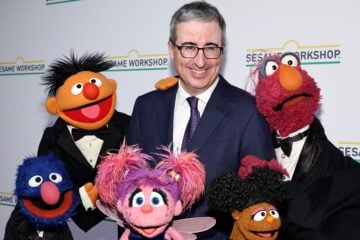‘170 Million Americans’ drive begins to defend federal aid
On average every month, 170 million Americans go to television, radio, online services and in-person events offered by public media. That crowd amounts to more than half of the country’s population.
Surprised? That’s just what the slogan writers are hoping for.
The line “170 Million Americans for Public Broadcasting” debuts this week on a new website — 170MillionAmericans.org — intended to help defend public broadcasting from potentially dire funding cuts looming in the new year.
The site is sponsored by nine national public TV and radio organizations and co-managed by two of them, the Association for Public Television Stations and Minnesota-based American Public Media.
The big audience statistic reveals for the first time a comprehensive estimate of public media users across all platforms. Public radio’s Station Resource Group spent months – long before this campaign was devised — gathering the data and subtracting people in overlapping audiences who could be counted more than once.
The number is what gives the plan its wallop. It’s much more powerful than the last concerted effort to lobby Congress on funding cuts, launched in April 2006. “Tell Them Public Matters” simply said, “Public broadcasting matters to millions of Americans.”
In a press release last week to stations, APTS and APM said the 170 Million Americans campaign will be “a collaboration of public radio and television stations, national organizations, producers, viewers and listeners throughout the country in favor of a strong public media in the United States.” They expect to mobilize “a grassroots network of hundreds of thousands of Americans ready to act on behalf of public broadcasting.”
The campaign specifically does not mention what sparked House Republicans’ determination to kill off pubcasting money: NPR’s October firing of news analyst Juan Williams after he acknowledged that people in Muslim attire on an airliner make him nervous.
The controversial dismissal was “absolutely set aside” in developing the campaign, said Bill Gray, APM spokesperson. “This is not about Juan Williams at all.”
“I think it’s a natural to go broad with the campaign,” Gray said. “It’s the concept of public media that’s under attack.”
Calling all grassroots
In addition to APTS and APM, the ad hoc committee of pubcasting groups working on the campaign — the Station Research Group, National Federation of Community Broadcasters, PBS, PRI, Association of Independents in Radio, NPR and Public Radio Exchange — is counting on some of those 170 million Americans to share stories about how public media affect their lives. As always, campaign planners point out that grassroots advocates will be most effective in moving Congress. While lawmakers may bluster in Washington about cutting aid to pubcasting they’re usually fans of their local stations — because their constituents are, particularly in small and remote communities.
“It’s all very simple,” Gray said. Site visitors obviously feel that funding to public media is important. “They will say to their members of Congress, ‘Here’s why I think that’s true.’ They’ll talk about how public media has impacted them individually.” Resources on the site will explain how to contact congressional representatives, and suggest talking points. There’ll also be a mechanism to capture testimonials — not necessarily videos, at least at first, but short first-person essays or statements. The site is a work in progress, Gray said.
The site will also inform users of up-to-the-minute Capitol Hill developments. “We’ll give both stations and individuals information on what is happening when so they can weigh in,” Gray said.
The tasks are similar to those handled by “Tell Them Media Matters,” a website created to counter House Republicans’ 2005 attempt to reduce funding of the system. That site also highlighted individual stories. But, a few years later, pubcasters can reach out much farther and deeper through social media such as Facebook and Twitter.
Stations that opt to participate in the campaign will be asked to place links from their sites to the campaign site. Their names will be listed on a “partners” page. The station signup page says: “You are not committing to any other action, however we will be in touch with suggested tactics that will help engage your audience, members and other stakeholders. All of these activities are optional.”
Gray said participating stations also will have no obligation to pay for the campaign.
Also, the campaign says it’s not using federal money in any way.
That’s important: Section 509(B) of the 1993 Labor-HHS appropriations bill forbids using any part of public broadcasting’s federal subsidy to influence legislation.
The site is an “opt in” service; no station e-mail lists will be used to solicit supporters.
Science to the rescue
The campaign, like penicillin, grew out of an unrelated experiment. SRG wanted to see if it could determine with some precision how many Americans interact with all sorts of public media each month.
Tom Thomas, co-c.e.o. of SRG, said the need for the figure became obvious during research for pubradio’s Grow the Audience Project, which delivered its report last winter.
“We’ve been exploring at SRG for months how might to get at a cross-platform, multimedia audience figure,” Thomas said. “That’s the way we’re talking about what public media is these days: a service that connects with America on multiple platforms. So this is not a new topic.”
Tracking and reporting online usage has significantly improved in recent years, Thomas said. “Now we can get at some sense of the intersection between the online and broadcast audience from site to site,” he said. “There are lots of data points.” With numbers from PBS, NPR, CPB, Arbitron, Nielsen and online reporting agencies, SRG was able to compile a fairly accurate number, he said.
The real challenge was to sift out people counted more than once. “In each potential area of overlap, we find the best reporting and do a ton of calculations” to estimate the folks who, say, watch Frontline, listen to Morning Edition and visit PBS.org. Those formulas included matching PBS’s monthly audience numbers to NPR’s weekly. Nielsen also tracks some multiplatform use.
In all calculations, Thomas said, “we erred on the side of caution,” especially to prevent pubcasting foes from attacking the 170 million figure. In the end, he said, 170 million “feels pretty tight at the moment.” (See below for an explanation of how the number was figured.)
After House members began their attack on CPB appropriations in November, APM approached SRG and asked whether the unrelated audience calculation could help pubcasting make its case to legislators and the public. “Our sense was, that’s exactly the right way,” Thomas said.
Gray is not sure how long the system will leave the new website up. Congressional action on CPB funding is expected to continue well into the spring.
“170 Million Americans for Public Broadcasting” positions the campaign perfectly, Thomas said. “This is about the incredible reach and impact our resources have on tens of millions of people per month — more than half of all Americans,” he said. “That number is just astounding.”
The Public Media Audience
Here’s how the 170MillionAmericans.org site presents the size of public broadcasting’s audience.
Every month over 170 million Americans use public media — through 368 public television stations, 934 public radio stations, hundreds of online services, education services, and in-person events and activities.
Every month over half of all Americans use public media.
- Public television has a monthly broadcast audience of 121.9 million people. Each viewer is counted only once, whether they watch one program or many. (Source: Nielsen NTINPower October 2010 Total Day 6a-6a Reach US Persons 2+)
- Public radio has a four-week broadcast audience of 64.7 million people. Each listener is counted only once, no matter how many times or public stations they tune in. (Source: Arbitron Spring 2010 National Regional Database, CPB Station Composite, Persons 12+, M-Su 6a-12m, US Total, compiled by the Radio Research Consortium)
- Network websites reach 13.7 million unique visitors per month at npr.org (Omniture SiteCatalyst, 3 month average, Aug-Oct 2010),10.8 million unique visitors per month at pbs.org (Google Analytics, October 2010), and 9.5 million average unique visitors per month at pbskids.org (Google Analytics).
- Station websites serve growing numbers of users – from a few thousand unique visitors per month in smaller communities to several hundred thousand unique visitors per month in major markets. Google Analytics, reported by Public Media Metrics
- Other digital media reach millions of people each month – through podcasts, mobile devices, smart phone apps, and satellite channels. Examples include 972,000 monthly unique users of NPR Mobile Web and 692,000 monthly unique users of the NPR News iPhone App. OmnitureSiteCatalyst, 3-month average, July-Sept. 2010
- Public media educational technologies and services are resources for millions of teachers and students through instructional TV content, interactive video and distance learning systems, online professional development for K-12 teachers, and workshops and services for childcare providers, pre-school instructors, and classroom teachers.
- In-person connections. Stations and producers connect in-person with regular activities and special events including, concerts and performances, lectures and forums, workforce development programs, and oral history projects. Many of these activities are partnerships with local school districts and educational institutions, museums and libraries, and national institutions, including the Library of Congress and the Smithsonian.






